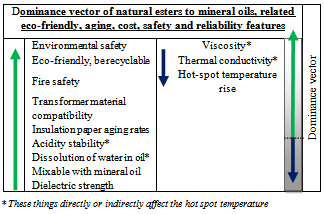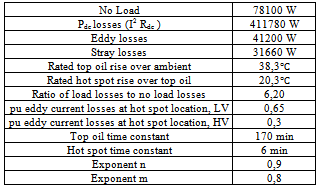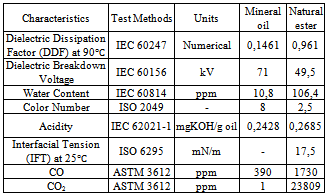-
Paper Information
- Next Paper
- Previous Paper
- Paper Submission
-
Journal Information
- About This Journal
- Editorial Board
- Current Issue
- Archive
- Author Guidelines
- Contact Us
Electrical and Electronic Engineering
p-ISSN: 2162-9455 e-ISSN: 2162-8459
2012; 2(3): 141-146
doi: 10.5923/j.eee.20120203.06
Aging of Paper Insulation in Natural Ester & Mineral Oil
Yunus Biçen1, Yusuf Çilliyüz2, Faruk Aras2, Guzide Aydugan3
1Industrial Electronics Dept. Duzce Univ. TR-81010 Uzunmustafa Duzce, Turkey
2Electrical Edu. Dept. Kocaeli Univ. TR-41380 Umuttepe Izmit, Turkey
3Schneider-Electric Turkey, TR-41410 Gebze Kocaeli, Turkey
Correspondence to: Yunus Biçen, Industrial Electronics Dept. Duzce Univ. TR-81010 Uzunmustafa Duzce, Turkey.
| Email: |  |
Copyright © 2012 Scientific & Academic Publishing. All Rights Reserved.
This paper presents an assessment on aging model of IEEE and IEC standards using thermal model of oil-immersed power transformer for natural ester and mineral oil. For this purpose, a model created for the behaviour of transient thermal performance with aging of natural ester and mineral oils. Thermal model of the transformer is based on thermal-electrical analogy that is calculated separately for natural and mineral oils covering top-oil and hot-spot temperatures. The hot-spot temperature values of each ester/oil are used to calculate aging parameters which include the aging acceleration factor, time dependent relative aging rate and insulation life loss variations. In this study, mineral oil and natural ester are kept under temperatures which are 100℃ and 140℃ in different periods. Natural ester’s characteristics are higher than mineral oil’s, except its breakdown voltage. In addition, natural ester absorbs more water than mineral oil so it is understood that deformation of the insulating paper in natural ester is lower. Natural ester has important benefits to decelerate aging of insulation. There is a model which is proposed for natural ester oil–immersed transformers and there should be used an aging factor as R to predict remaining life.
Keywords: Aging, Paper Insulation, Thermal Model, Natural Ester, Mineral Oil
Article Outline
1. Introduction
- Today, clean energy is emerging as a new trend in electric power systems. Therefore, green oils have been preferred as liquid insulator in power transformers especially since 2000. Green oils have three most important features, have slow down the impact of the aging process; provide a safe work performance and are biodegradable as close to 100%. Green oils named as the natural esters can be mixed with mineral oils and their utilization rates are increasing every day due to non-toxic and eco-friendly features. Thermal aging of insulation materials in mineral oil–immersed transformers have been formulated in ANSI/IEEE–C57.91 and IEC–354.91 standards[1, 2]. However, these formulas should be revised again for natural ester due to slow down the aging process. There are some differences between IEEE and IEC standards on thermal aging methods for mineral oil-immersed transformers. According to IEEE, normal lifetime of the power transformers equals to 20.55 years, whereas a total life has not been defined by the IEC standards, but it is usually equal to 30 years depending on the aging rate determined by the hot spot temperature[3, 4]. Hot spot temperature of natural ester–immersed transformers is higher than that of mineral oil–immersed transformers. And it is emphasized that the deviation of the hottest temperature between the two is increased with load[5, 6] because when the natural ester is compared to mineral oil, viscosity is higher and thermal conductivity is lower[5, 6] nevertheless, there is amount of soluble water transferred from Kraft paper to the natural ester more than mineral oils. That’s the reason why the paper is slow down aging and less deterioration in natural ester. Other positive features of Natural ester are presented in Table 1.
|
2. Thermal Model and Life Loss Equations
2.1. Top-Oil and Hot-Spot Thermal Models
- The top oil thermal model is based on the equivalent thermal circuit theory proposed by G. Swift. The differential equation for the equivalent circuit is[15];
 | (1) |
 is the top oil time constant, min.∆θ oil-R is the rated top oil rise over ambient, K.n is the exponent defines non-linearity.As the same mentioned method, the differential equation used to calculate the hot spot temperature is;
is the top oil time constant, min.∆θ oil-R is the rated top oil rise over ambient, K.n is the exponent defines non-linearity.As the same mentioned method, the differential equation used to calculate the hot spot temperature is; | (2) |
 is the winding time constant at the hot spot location, min.
is the winding time constant at the hot spot location, min.2.2. Insulation Life Loss
- The IEEE guide recommends that users select their own lifetime estimation. In this guide, 180 000 hours (20.55 years) are used as a normal lifetime[3].It is assumed that insulation deterioration can be modelled as a per unit quantity for a reference temperature of 110℃, the equation for accelerated aging is[3,4];
 | (3) |
 | (4) |
 | (5) |
 | (6) |
 | (7) |
3. The Proposed Method and Transient Modelling
- In this study, two different models are created in Matlab-Simulink for natural ester and mineral oil immersed power transformers which have the same technical specifications (ONAF-250MVA). Parameters of the power transformer were taken in IEEE Loading Guide and specifications are shown in Table 2.The established model has two stages. In first stage, ambient temperature and load factor are taken as input parameters. The hot-spot temperatures that will be used in loss of life calculation are found out by using these parameters by running the thermal model. However, the hot spot temperature calculation procedures are different for natural ester and mineral oil immersed transformers.
|
|
 | Figure 1. Proposed thermal model and aging calculation stages |
4. Experimental Studies
- Samples of mineral oil and natural ester are kept under temperatures of 100℃ and 140℃ for different periods. Test results are given by Table 4, and Table 5 respectively. Images of the held samples are also shown in Figure 2. The results show that characteristics of natural ester are higher than mineral oil, except its breakdown voltage. Additionally, as it can be seen that water content results; natural ester absorbs more water than mineral oil. This means that deformation of the insulating paper in natural ester is lower.In addition, the results of the gas analysis show that CO2/CO ratio which defines aging stage of cellulosic insulation material is very different. The ratio is under three for mineral oil, while it is above seven for natural ester. Equivalent test transformers are operated such condition that corresponds to double rated current in order to evaluate the heating performance of mineral oil and natural ester. Hot spot temperatures are measured by fibre optic sensor. It is observed that the temperature differences of mineral oil and natural ester are between 10℃ and 15℃. The aging characteristic of insulting material is affected from the temperature. The natural ester immersed transformer is more heated than the mineral oil immersed transformer under the same conditions.
|
|
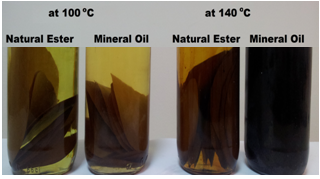 | Figure 2. Differences in appearances between natural ester and mineral oil with Kraft papers |
5. Results and Discussions
5.1. Transient Thermal Characteristics
- The load step variation for 750 minutes time duration is shown in Figure 3. Calculation of the hot spot temperature and top-oil temperature for mineral oil-immersed power transformer using thermal model are shown in Figure 4. It can be seen that the temperature rise for the certain time periods does not reach to the steady state point.
 | Figure 3. Load step changes (IEC 60076- Part 7) |
 | Figure 4. Temperature responses for mineral oil |
 | Figure 5. Hot-spot temperature differentiation between natural ester and mineral oil |
5.2. Transient Aging Characteristics
- In order to determine aging characteristics clearly, the load time duration is increased to 48 hours, and load sample repeats three times in this duration. The following situations are analysed using the model. · Aging acceleration factor variation· Time dependent relative aging rate variation· Life loss variationFigure 6 (a) and (b) shows the acceleration of aging for natural ester and mineral oil. Although the aging characteristics are the same, the aging acceleration factor of mineral oil is approximately two times higher than that of natural ester. Also, this affects to the relative aging rate. As shown in Figure 7, trend of the relative aging rate instabilities for natural ester and mineral oil decreases as the time increases. The life loss variation of the solid insulation which is misknown as transformer life loss is shown in Figure 8.
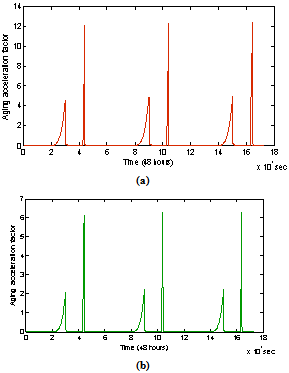 | Figure 6. Aging acceleration factor variations, (a) for mineral oil, (b) for natural ester |
 | Figure 7. Time dependent average relative aging rate variations, (a) for mineral oil, (b) for natural ester |
 | Figure 8. Life loss variations, (a) for mineral oil, (b) for natural ester |
6. Conclusions
- The results of this study show that the natural ester has significant benefits in slowing down aging of insulation. Solid insulation life loss variations which is mentioned as 5-8 times slower at the same temperature, experimented by modelling two different 250 MVA power transformers which have the same technical characteristic features for mineral oil and natural ester. The factor R should be added to the proposed model for natural ester and, its temperature rise more than that of mineral oil is also considered in this study. Particularly, natural ester-immersed transformer is very advantageous in the nominal operating conditions. This advantage decreases with increasing load values over the nominal operating condition.
Acknowledgements
- This work is supported by the Scientific Research Projects Unit of Kocaeli University. Project number: 2010/33.
 Abstract
Abstract Reference
Reference Full-Text PDF
Full-Text PDF Full-Text HTML
Full-Text HTML